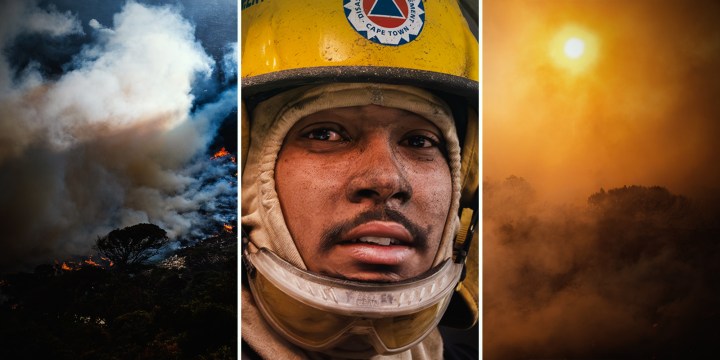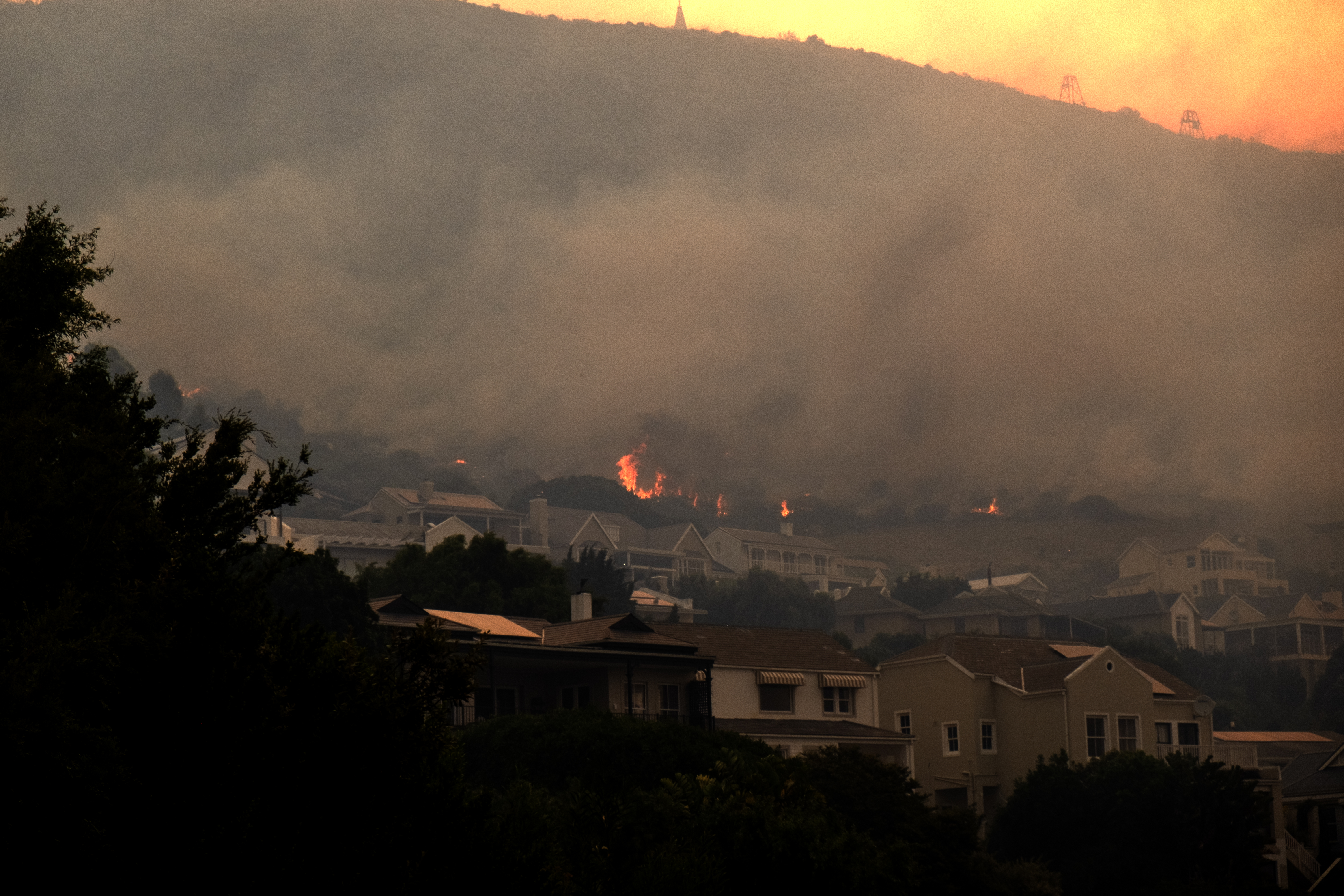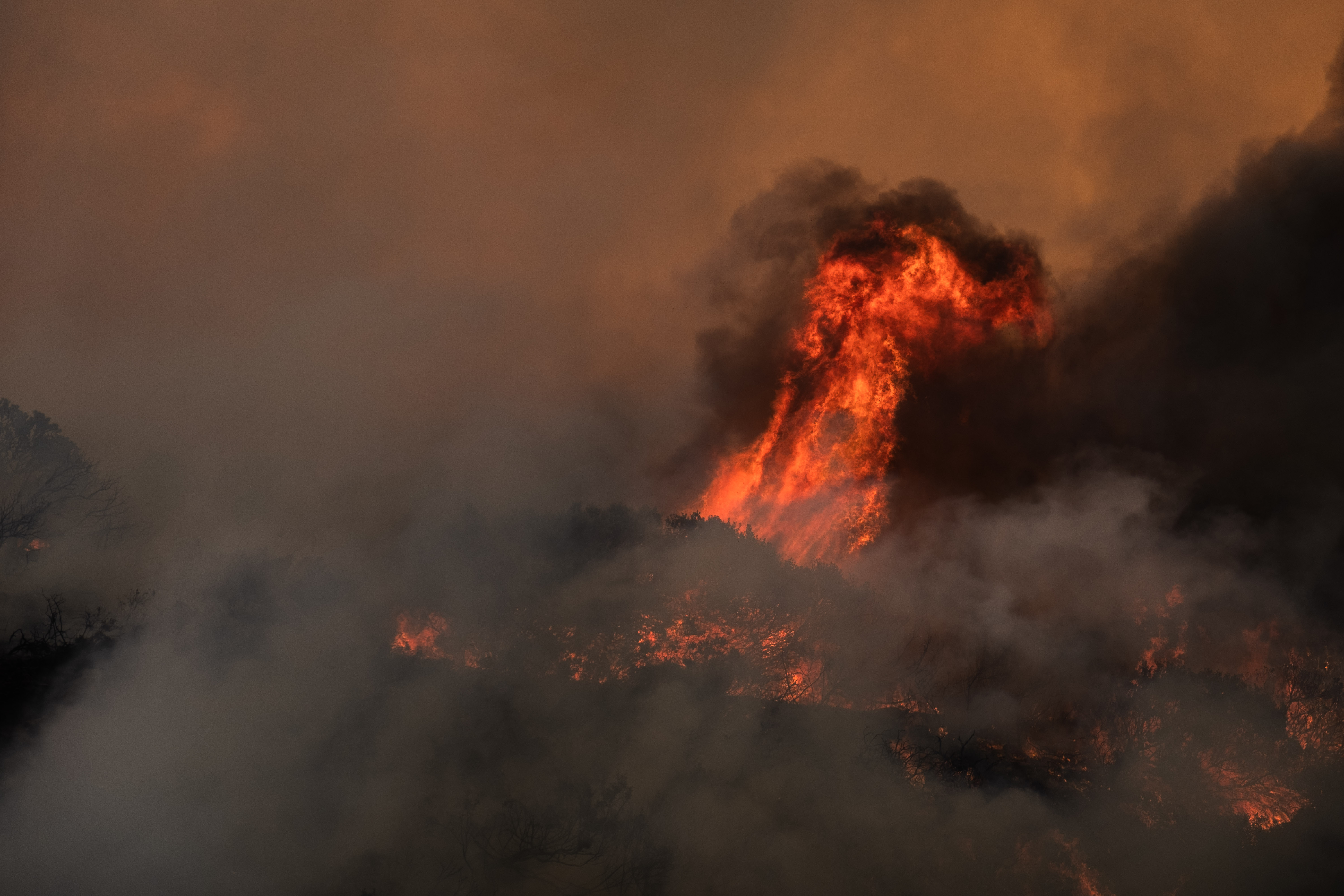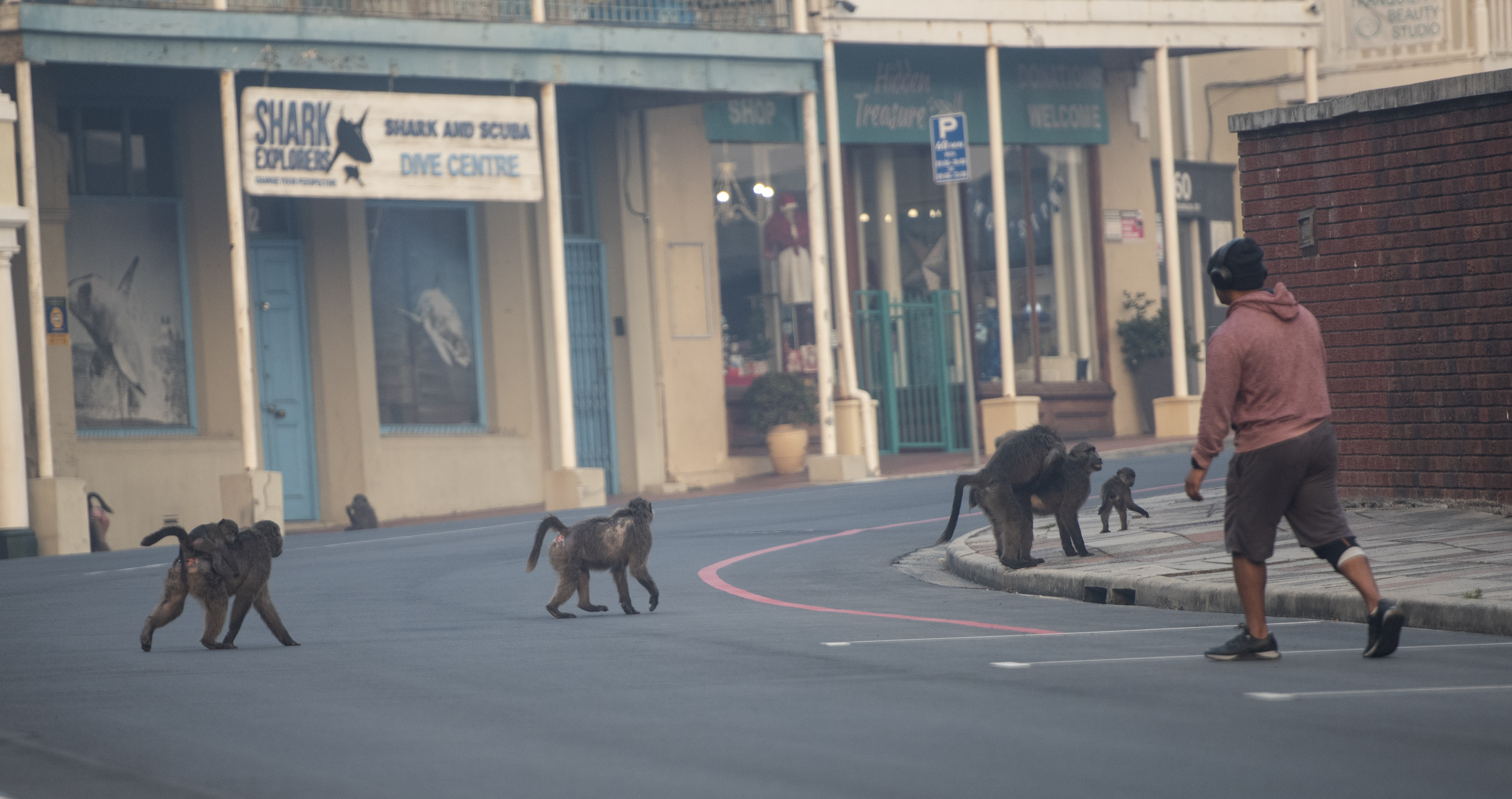WESTERN CAPE WILDFIRE
What is making Deep South fire so severe and why are more deadly fires likely to occur?

It’s worth trying to understand what made the runaway fires around Simon’s Town so severe and under which conditions a much more dangerous fire could occur in the area, especially as climate change projections for Cape Town suggest generally worsening fire weather conditions well into the future.
By Friday morning a raging wildfire, that originated on the mountain slopes above Castle Rock near Simon’s Town on Tuesday, 19 December, had spread to Scarborough with several evacuations during the night and early hours of this morning.
Simultaneously, the vegetation fire reported along Glencairn Expressway rapidly intensified, advancing in the direction of Stonehaven and Evergreen Estates.
Increased heat, windy conditions, and drier vegetation, not to mention mismanagement, have created the perfect storm for increased risk of fire and quick spread of these fires that continue to ravage the Cape.
With strong winds still fanning the fire and aerial support craft supporting water bombing on Friday morning, learning from these events can help build resilience against anticipated harsher fires by mitigating property risk, saving lives, and preserving biodiversity.
Regarding the severity of the ongoing wildfire from Simon’s Town, Table Mountain National Park (TMNP) confirmed on Thursday that approximately 1,140 hectares of land across private, public works, and TMNP properties had been burnt since Tuesday, December 19.
Read more in Daily Maverick: Simon’s Town blaze rips through 450ha, hundreds of firefighters continue battle
According to TMNP, the fire — which was described as wind-driven — ignited amidst extreme weather conditions of exceptionally high temperatures, low humidity, and robust southeasterly winds. These factors, combined with arid vegetation, provided an optimal setting for rapid fire spread due to the high fire danger index.

The fire, which began near Castle Rock has made its way across the mountain, just above houses in Simons Town. 19 December 2023. (Photo: Kyra Wilkinson)
The escalation in wind speed, along with consistent shifts in direction, intensified the spread of the fire across multiple areas — as was seen on Thursday night when the fire raged on for a third night and evacuations spread to Scarborough.
Read more in Daily Maverick: Relentless blaze lays siege across Simon’s Town for third consecutive night, Scarborough evacuates
Never mind the fact that the worst fire season in eight years is expected in the Western Cape for 2023/2024.
City of Cape Town’s Fire & Rescue Service spokesperson, Jermaine Carelse, said the wind was the biggest factor complicating firefighting efforts.
Since the fire started, the City’s Disaster Risk Management Centre spokesperson, Charlotte Powell, confirmed that approximately 30 to 40 households were evacuated as a precautionary measure and that most of these people opted to stay with friends or relatives, but the local community hall was also made available.
Fire conditions in the Cape
The wet winter experienced in the Cape was expected to reduce the risk of severe fires in the early fire season, but the windy and dry conditions experienced appear to be drying out the vegetation around Cape Town at a surprisingly fast pace.
Since the beginning of December, the City of Cape Town’s Fire Service has already responded to 1,500 vegetation fires, a significant increase from last year when they responded to 1,100 vegetation fires in the same period.
Stefaan Conradie, a climatologist from the Climate Systems Analysis Group at the University of Cape Town, told Daily Maverick, that climate change projections for Cape Town suggest generally worsening fire weather conditions in future: longer, warmer and drier summers, with more frequent southeasters. However, humidity may also increase, complicating the picture, as well as the fact that some studies have found decreasing wind speeds in the long term.
However, he said that climate change doesn’t seem to be strongly at play with the current fires in the Cape.
“We had a very wet winter and extremely wet September. October was very dry, though, and November one of the warmest on record for Cape Town. Since then, December hasn’t been particularly warm or dry compared to normal, but it has seemed windy,
“There is a very strong southeastern blowing, which is driving the fire and risking fire fighting, but that’s not unusual in Simon’s Town in summer. Publicly accessible data does not suggest extreme fire weather conditions,” he said.
Fires in the area around Simon’s Town are not unusual but Conradie said the Simon’s Town fire is burning over a much larger area of mostly natural vegetation under fire weather conditions in the core fire season.

Flames explode in the air on the hill below Rocklands farm, Murdoch Valley in Simon’s Town on 20 December 2023. (Photo: Kyra Wilkinson)
Trevor Abrahams, managing director of Working on Fire, agreed: “This [Simon’s Town] fire is not atypical for the Table Mountain Range, to have this kind of burn because of this vegetation. In this case, the fire is bordering an area that hasn’t burned for [approximately] 40 years, and the fynbos here needs to burn every 10-15 years to propagate properly. So if the fire reaches these areas, obviously we will have quite an intense fire breaking out. The Table Mountain range is also further exacerbated by the wind patterns in this area. This is a wind-driven fire.”
This appears to be the disaster unfolding on Friday morning.
Looking back at another extreme fire, Conradie explains that the Devil’s Peak/UCT fire of April 2021 occurred under extreme fire weather conditions and a North Westerly wind at the end of a long summer period, in a region with heavily invaded vegetation and transformed land that drove very extreme fire behavior.
Read more in Daily Maverick: UCT burns: Mountain inferno wreaks havoc in Mother City
“The main similarities with the April 2021 Devil’s Peak fire [and the current fires] are that both are Wildland Urban Interface (WUI) fires and that both burned in what would naturally be fynbos areas. Dense scrub, heavily infested with flammable alien vegetation appears to grow in abundance above certain parts of Simon’s Town, which would pose a much greater risk to people and structures in the area under more extreme fire weather conditions,” he said.
In most areas studied, increasing temperatures and an intensified hydrological cycle (more intense dry spells and more extreme rainfall events), have increased the frequency of extreme wildfire weather conditions.
“The limited evidence suggests this is true over the fynbos biome and Cape Town, too. This increases the likelihood and potential for extreme fire events. There is potential for much worse wildfire risk in the future under low mitigation scenarios,” Conradie said.
However, Conradie noted that other factors have probably had an even greater influence on the increasing frequency and intensity of severe and destructive wildfires globally, including:
- Excessive focus on fire-fighting that has led to build-up of huge fuel loads in certain areas;
- Rapid expansion and sprawl in the WUI;
- Uncontrolled spread of fast-growing, explosively flammable invasive alien vegetation; and
- Land use changes that have seen less effective fire management, in SA mostly abandoned or mismanaged forestry plantations.
Conradie said that a number of fire ecologists have worked on understanding the factors that contribute to extreme fires and what can be done to adapt to and mitigate these risks. “Their work should inform evidence-based and flexible policy that is responsive to evolving conditions.”
Hot, dry and windy conditions over the fynbos biome
“As temperatures increase globally, the increasing risk of hot, dry and windy conditions over the fynbos biome is expected to lead to more frequent weather conditions that could support extreme wildfire behaviour. But vegetation conditions, social factors and fire preparedness determine and response will determine how future fires evolve,” Conradie said.
Christopher Trisos, director of the Climate Risk Lab at UCT’s African Climate and Development Initiative, explained that fynbos have evolved to burn and wildfire is a natural part of the fynbos cycle that we have to work with. He said that many fynbos plant species need fire for their seeds to germinate and grow into the next generation of plants.
“The problem is when fires become too frequent, such as burning the same area every three years instead of every 15 years. Fires occurring too frequently in the same area damages the fynbos by pushing some species to local extinction when they are unable to grow and produce seeds in the shorter time between fires,” he said.
One source of more frequent fires is more frequent ignition of fires by people. Fynbos, a type of vegetation, requires controlled burning every six to 20 years for optimal growth (the ideal frequency depends on various factors), but as the population and tourism increase, more human activities lead to additional ignition sources.
Climate change and fire
Human-caused climate change is causing an increase in the frequency and intensity of hot and dry fire weather. Trisos said that heat and droughts linked to climate change can also increase the amount of dry vegetation available to burn, and so increase the area burned by fire.
“We are seeing this in forests in North America, Australia, and Brazil. Large forest fires increase greenhouse gas emissions, thereby further worsening climate change,” said Trisos.
For the fynbos, as mentioned above, fire is a natural part of the cycle of the ecosystem but research by Dr Jasper Slingsby has shown that longer, hotter, and drier summers after a fire can prevent the regeneration of many fynbos plant species, such as some restios, and change the composition of the fynbos over time.
In a region characterised by warm, dry, and windy summers with highly flammable vegetation, fires are inevitable, and some may pose significant risks. Conradie said that completely preventing such fires may not be realistic or reasonable. Instead, the focus should be on minimising the risk to people’s lives and health, especially for firefighters, and reducing the overall cost and risk to structures and infrastructure.
Minimising the risk to people and properties
On Wednesday, Ashleigh Olsen, a local Simon’s Town resident and member of the Seaforth Community Baboon Project, spent the night helping a friend evacuate. She told Daily Maverick that while the Simon’s Town fire may have started on private property if the right systems were in place throughout the year and previous years, the damage would have been severely reduced.
“My deepest gratitude is to all the people on the ground and in the air who are doing their best and working nonstop to try and stop this fire. Let’s see what we have left tomorrow,” she said.
Olsen added that the situation would have been “a hell of a lot worse” if it wasn’t for residents being proactive about their own safety and information sharing.

Baboons on the main road in Simons Town. 20 December 2023. (Photo: Brenton Geach)
“If the winds had got worse, I would like to have known what the evacuation plan was because we’ve got one way and one way out, which can succumb to fire. I was trying to plan where I would go. I was literally going to have to drive to the beach with my three cat boxes and my dog… Even with the evacuation plans [that were in place], none of that [information] was publicised,
“We have constant dialogue about the baboons here, which everyone is focused on, but what about the entire mismanagement of this area from waste to fire control? I call it inattentional blindness… A huge amount of habit has happened in this area due to these fires, we haven’t even begun to measure what has been lost but we need to know what is the plan to address this habitat loss and assist the wildlife in this area with recovery. We cannot expect animals to survive on ash and rock,” said Olsen.
SANParks implements invasive plant clearing programmes such as Working for Water and invests millions annually into invasive plant clearing within TMNP throughout the year, when conditions are favourable.
Justin Buchmann, TMNP Integrated Fire Manager, said that these programmes have a number of ecological benefits including biomass reduction which adds fuel to the fires.
“The critical intervention going forward will be to ensure that follow-up post fires happen and that it is applied consistently, not just inside the national park but on land managed both privately and by other authorities. This will go a long way in terms of reducing the intensity of the fires,” he said.
2023 worst fire season ever globally
Working on Fire’s Abrahams told Daily Maverick that the 2023-2024 fire season is expected to burn through hundreds of hectares as a result of human negligence and increased temperatures, resulting in bigger fires that are more intense, more frequent, and occur in areas that do not normally burn.
Read more in Daily Maverick: Western Cape braced for worst fire season in eight years
“As conditions get drier and hotter, it’s already evident that 2023 is the worst fire season ever globally. So the hotter, dryer weather conditions, along with the transition from La Niña to El Niño has had an impact on the Simon’s Town fire and other fires this season,” he said. DM
Update on 24 December, 2023: Relentless fire-fighting efforts continued through the weekend to douse hot spots and new flareups, the city of Cape Town reported. The operation was scaled down on Saturday and all evacuees had returned to their homes, with the use of a drone to identify hotspots. The Cape of Good Hope/Cape Point section of Table Mountain National Park, previously closed due to safety concerns amid the fires in the Simonstown area, was due to reopen on Saturday to visitors.




















 Become an Insider
Become an Insider
The fire risks posed by, and, informal settlements means they must be an absolute no-no in the whole southern peninsula. Absolute and total enforcement, and no camping with open fires anywhere in this same area.
True. If people in southern peninsula want lower paid workers, then large scale low-cost housing is an urgent need in southern peninsula to eliminate informal housing risks.
In the alternative, jobs need a R3k per month transport levy per employer to transport lower paid workers from elsewhere.
Forced removals are the solution to everything? So immediately, without evidence, you blame the black and poor for this fire?
Have you noticed how many fires start, and devastate, informal settlements? A very frequent occurrence.
Yes, but that does not mean all fires are started in informal settlements, or their residents.
I’m from that area and yet the first thing that comes to your mind is a racist statement, not cool Max. Trust me I have seen the fires around Jeffreys Bay in that settlement just as you come into the town and it’s not cool. Makes you wonder why the Gunston surfing was moved away hey. Think logically, not politically and you will see you come up with better answers.
And you, Max, you are happy leaving these communities in the very heart of these searing blazes? Stop analysing everything in our country through your usual black/white lens and look for solutions.
Some good points eg that invasives need eradicating and that fynbos nearish to human habitation and farmldnd may need controlled burns, but article jumps all over the place, needs editing, and makes the accusation (based on one interview) that residents were left in the dark to fend for themselves.
Hmm, so some areas of fynbos have not burned for 40 years when an average interval of 15 years is optimal.
As usual and article explaining a natural disaster tries hard to blame it on climate change.
Notice how the 4 points set out are all human causes.
Notice how they always say wild fires are expected to increase in frequency. Bit reality is that they have not yet. Despite the 1.2° temperature increase.
Globally droughts have not increased. Nor have extreme heat waves. They are expected to in the models but these are not yet in the global record.
They mentioned North America. There wilds fires have increased marginally since 1983. But over the last century they are down significantly. Like 90% down. And when studied the causes are well documented to be mismanaged forestry. Something noted in the SA context at all.
Blaming climate change is misinformation. Purely political.
Yes sure, we should burn more coal and more oil because carbon is good for plants and we all need more plants.
I’m taking a different and selfish stance though. My factory produces more solar energy than it consumes and I use batteries to avoid diesel. I am ashamed to admit that this is due to selfish narrow economic interests.
I’ll try to consume and pollute more next year, promise.
Hi the reporting on this is good but its important to clarify most/alot of these fires are not of natural causes but incidents of arson
JP Smith
16h00
*ARSON OR SABOTAGE- OUR CITY UNDER ATTACK*
On Thursday, our Fire and Rescue department responded to a fire that had been started close to the water treatment works at the Steenbras dam above Gordon’s Bay. Aerial firefighting and ground crews continued throughout the day and into the night to contain the blaze.
In the course of the evening, firefighters had to be despatched to a fire that was reported in Slangkop, but shortly before midnight, a call was received for a fire close to Pinehaven, on the peak of Redhill Rd in Simonstown.
Crews responding to the fire line became suspicious of a vehicle hurriedly leaving the area upon the arrival of the first fire engine. With the fire dangerously close to the water treatment works of the Kleinplass reservoir, teams battled throughout the night, and additional aerial support was requested at first light.
While the blaze has been contained and the water treatment facility protected, members from the City’s Water and Sanitation department are currently assessing the water supply infrastructure network for resulting damages, as firefighters and crew continue with dampening down of hot spots areas.
SANParks has also now recorded an unprecedented level of fires within the park in recent times and has called on Enviro Wildfire Services to investigate these incidents and to prepare a report that will establish where the liklihood of arson exists in these recorded occurrences.
In both of the instances affecting the City of Cape Town’s water supply network, the City must condemn such devious attempts to disrupt vital aspects of service delivery.
Damage to critical infrastructure can carry a prison sentence of up to twenty years, of those found damaging such vital aspects of the City’s water supply network. The City is offering a reward for information that will lead to the arrest of any person responsible for the fire that threatened either of the Steenbrass or Kleinvlei water treatment facilities.
Any person with information or who observes suspicious activity within the TMNP or any of the City’s facilities should report it immediately to the PECC by calling 021-480 7700.
If any sign of fire is seen, the public is requested to please report these immediately to the numbers listed above.